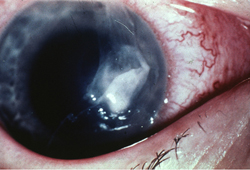全球至少有 22 亿人患有近视力或远视力障碍。[1]World Health Organization. Blindness and vision impairment. Oct 2022 [internet publication].
https://www.who.int/news-room/fact-sheets/detail/blindness-and-visual-impairment
在几乎一半的这些病例中,视力障碍可能是可以预防的或仍未得到治疗。[1]World Health Organization. Blindness and vision impairment. Oct 2022 [internet publication].
https://www.who.int/news-room/fact-sheets/detail/blindness-and-visual-impairment
大多数视力障碍和失明患者的年龄在 50 岁以上;但是,视力丧失会影响所有年龄段的人。[1]World Health Organization. Blindness and vision impairment. Oct 2022 [internet publication].
https://www.who.int/news-room/fact-sheets/detail/blindness-and-visual-impairment
2020 年,全球≥50 岁人群失明的主要原因是白内障,其次是青光眼、矫正不足的屈光不正、年龄相关性黄斑变性和糖尿病视网膜病变。[2]GBD 2019 Blindness and Vision Impairment Collaborators; Vision Loss Expert Group of the Global Burden of Disease Study. Causes of blindness and vision impairment in 2020 and trends over 30 years, and prevalence of avoidable blindness in relation to VISION 2020: the Right to Sight: an analysis for the Global Burden of Disease Study. Lancet Glob Health. 2021 Feb;9(2):e144-60
https://www.ncbi.nlm.nih.gov/pmc/articles/PMC7820391
http://www.ncbi.nlm.nih.gov/pubmed/33275949?tool=bestpractice.com
当泪膜到枕叶皮质区的视通路中任何一点存在异常时,可能出现视力丧失。最初需确定的最重要因素是症状发作的快速性。早期评估是否存在疼痛、复视、闪光和/或飞蚊症等伴随症状也很重要。这有助于识别存在可能危及生命疾病的患者,并且让需要立即接受眼科评估或手术干预的患者得到重视。[3]Rossi T, Boccassini B, Iossa M, et al. Triaging and coding ophthalmic emergency: the Rome Eye Scoring System for Urgency and Emergency (RESCUE): a pilot study of 1,000 eye-dedicated emergency room patients. Eur J Ophthalmol. 2007 May-Jun;17(3):413-7.
http://www.ncbi.nlm.nih.gov/pubmed/17534826?tool=bestpractice.com
[4]Ramos M, Kruger EF, Lashkari K. Biostatistical analysis of pseudophakic and aphakic retinal detachments. Semin Ophthalmol. 2002 Sep-Dec;17(3-4):206-13.
http://www.ncbi.nlm.nih.gov/pubmed/12759852?tool=bestpractice.com
突然发生或者在数分钟到数小时内发生的急性视力丧失通常需要紧急咨询眼科。亚急性或慢性视力丧失患者(视力丧失在数周、数月或数年内发生)可能仍需要专科医师建议,但通常不是紧急事宜。
任何显著的视力丧失都需要眼科医生会诊,以获取关于转诊时机的建议。
视力丧失也可能是多种全身性疾病的首发症状,需要进一步检查。[5]Klig JE. Ophthalmologic complications of systemic disease. Emerg Med Clin North Am. 2008 Feb;26(1):217-31.
http://www.ncbi.nlm.nih.gov/pubmed/18249264?tool=bestpractice.com
急性视力丧失
视网膜或视神经疾病通常表现为急性发作。其他视力丧失的急性原因包括急性闭角型青光眼、视网膜血管阻塞和外伤。回顾性数据表明,在英国,接受紧急眼科服务的患者中占比最大的患者群年龄为 50-90 岁,这可能是因为出现玻璃体视网膜、视网膜血管、黄斑疾病等眼部急症的风险增加。[6]De Silva I, Thomas MG, Shirodkar AL, et al; BEECS Study Group, Buchan J, Verma S. Patterns of attendances to the hospital emergency eye care service: a multicentre study in England. Eye (Lond). 2021 Nov 30:1-8.
https://www.ncbi.nlm.nih.gov/pmc/articles/PMC8629695
http://www.ncbi.nlm.nih.gov/pubmed/34845355?tool=bestpractice.com
因眼部创伤到急诊科就诊的患者年龄较小。[7]Fea A, Bosone A, Rolle T, et al. Eye injuries in an Italian urban population: report of 10,620 cases admitted to an eye emergency department in Torino. Graefes Arch Clin Exp Ophthalmol. 2008 Feb;246(2):175-9.
http://www.ncbi.nlm.nih.gov/pubmed/18183412?tool=bestpractice.com
[8]Galindo-Ferreiro A, Sanchez-Tocino H, Varela-Conde Y, et al. Ocular emergencies presenting to an emergency department in Central Spain from 2013 to 2018. Eur J Ophthalmol. 2021 Mar;31(2):748-53.
http://www.ncbi.nlm.nih.gov/pubmed/31865769?tool=bestpractice.com
患者的年龄和病史测定有助于诊断。
慢性视力丧失
患者可能“突然”发现慢性视力丧失的症状,意味着其可能因慢性视力丧失而到急诊科就诊,从而增加了诊断难度。
回顾相关症状有助于区分急症与非急症,并安排适当的眼科诊疗。
全身性因素
必须采集完整病史,侧重血管和神经病变以及视力改变病程。
糖尿病视网膜病变可在糖尿病确诊之前出现,因此对于所有出现急性视力丧失的患者,检测血糖水平非常重要。对所有新诊断出糖尿病的成年人安排眼科检查。[9]Jones HL, Walker EA, Schechter CB, et al. Vision is precious: a successful behavioral intervention to increase the rate of screening for diabetic retinopathy for inner-city adults. Diabetes Educ. 2010 Jan-Feb;36(1):118-26.
https://www.ncbi.nlm.nih.gov/pmc/articles/PMC4582664
http://www.ncbi.nlm.nih.gov/pubmed/20044537?tool=bestpractice.com
[10]Solomon SD, Chew E, Duh EJ, et al. Diabetic retinopathy: a position statement by the American Diabetes Association. Diabetes Care. 2017 Mar;40(3):412-8.
https://www.doi.org/10.2337/dc16-2641
http://www.ncbi.nlm.nih.gov/pubmed/28223445?tool=bestpractice.com
其他严重的全身性疾病(包括肉芽肿性多血管炎、细菌性脑膜炎或散播性恶性肿瘤)可能需要在急诊科或者入院进行处理。[11]Mitra A, Chavan R, Gunda M. Occult giant cell arteritis and steroid therapy: how urgent is urgent? Ann Ophthalmol (Skokie). 2006 Winter;38(4):343-5.
http://www.ncbi.nlm.nih.gov/pubmed/17726223?tool=bestpractice.com

登录或订阅即可浏览 BMJ Best Practice 临床实践完整内容